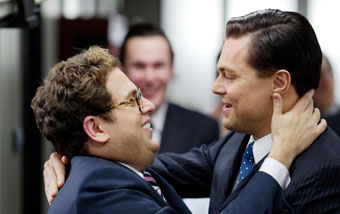
photo courtesy of Paramount Pictures & Red Granite Productions
The End of the Film
| published Saturday, January 18, 2014 |By R. Alan Clanton
Thursday Review editor
For a score plus a century, motion pictures have been shot, edited, distributed—and projected onto the big screen—using film, typically 35 millimeter.
That tradition may soon come to an end as more film production companies and studios continue their transition to fully digital formats. In a move that promises to have historic importance, Paramount Pictures released a statement to all of its participating theaters that the recent comedy Anchorman II would be the last movie it would release on celluloid film stock. Industry experts suggest that as Paramount goes, so goes the rest of the Hollywood majors.
Paramount, like some of the other Hollywood majors such as 20th Century Fox, Universal and Walt Disney, has been slowly converting to digital distribution for several years. Last year several new releases were offered only in digital format to theaters, including The Hunger Games: Catching Fire and The Wolf of Wall Street.
Three factors are now pushing the process of transition even faster.
One is theater conversion. Now that a vast majority of theaters, especially those who are part of the larger chains, have made the once-expensive upgrade to digital projection as an option, the studios feel they have less to fear from going fully digital. The major studios no longer worry about missing out on revenue from those few theaters still stuck with traditional projection methods. Unlike other technology advances (hydrogen-powered fuel cell cars, for example), this chicken and this egg have moved in tandem in their business model evolution.
AMC, for example, working closely with Sony, completed a costly three year transition of its theaters to digital at the end of 2012. Other major theater chains in North America, the U.K., Europe and Asia accelerated their conversions to digital at the end of the aught years, and now very few of the major theater companies have venues which still project using analog film.
The second factor is cost. Film—which was never cheap, even in the old days—is now greatly overpriced when compared to digital in cost per unit, and since fewer companies support hardware, maintenance, and supplies for film, the transition now seems unstoppable. Many theaters have converted fully to digital, and some are now installing satellite systems for direct beaming, or high speed digital platforms for direct downloads and uploads—distribution models that may reduce the cost of acquisition of a single movie to under $100. A traditional celluloid film could cost as much as $2500 per unit for delivery.
The third big issue is durability. Film is fragile and subject to costly forms of instant depreciation—including damage from breaks, scratches, heat and humidity, smoke, and a wide variety of environmental factors. Storage and maintenance of film is costly, and fraught with never-ending issues of deterioration. Digital distribution and projection bypass these problems and incur virtually no cost, except for computer hard drives and digital projection hardware. This means that theaters have little reason not to embrace the new business model.
Digital motion pictures are typically cached in a file called a DCP (digital cinema package), which can range in size from 100 to 340 GB. This means that an entire movie for theatrical projection can be contained on something the same size as a few Blu-ray discs.
Furthermore, advances within the digital realm—lighting, shooting, editing, special effects—have advanced with breathtaking speed, and helping to usher in faster, more nimble ways to produce ever-more-elaborate big screen projects (and some film purists would argue that the new digital processes make producers and directors lazy, since special effects can now do the work or difficult filmmaking must cheaper). Digital shooting and editing is also easily embraced now by the independent and smaller filmmakers who would have once—in the recent past—found the costs prohibitive.
Also contributing to the business model’s success is the fact that most Americans now watch movies through services like Netflix, through cable operators and satellite companies, or via fully digitized formats such as DVD or Blu-ray. Conversion directly to these digital pipelines and formats is easy and relatively-cost free.
For these reasons, motion picture industry experts believe that the transition to all-digital distribution will go quickly within the next two to three years. Paramount’s decision was, in fact, inevitable, and industry experts now believe that 20th Century Fox, Universal, Warner Brothers and others will soon follow this path.
For those nostalgic about film, there are downsides. Some see digital distribution as the death knell for what remains of locally-owned, independent theaters, or the art house theaters which specialize in second-run or retrospective showings (examples: the San Marco Theater in Jacksonville, FL, and The Guild in Albuquerque, N.M.). And the conversion to digital may force some of the remaining indie and smaller theater franchises—those who cannot afford to make the transition to digital projection systems—out of business.
Still, many screenwriters and directors—as well as actors—bemoan the eventual loss of film, and many have joined in a group effort to maintain film. The preservation of tens of thousands of films now archived in the old format has become a priority for many who still view the craft of the motion picture as an essential analog and photographic art form.
Thursday Review will have more on this topic in the near future.
